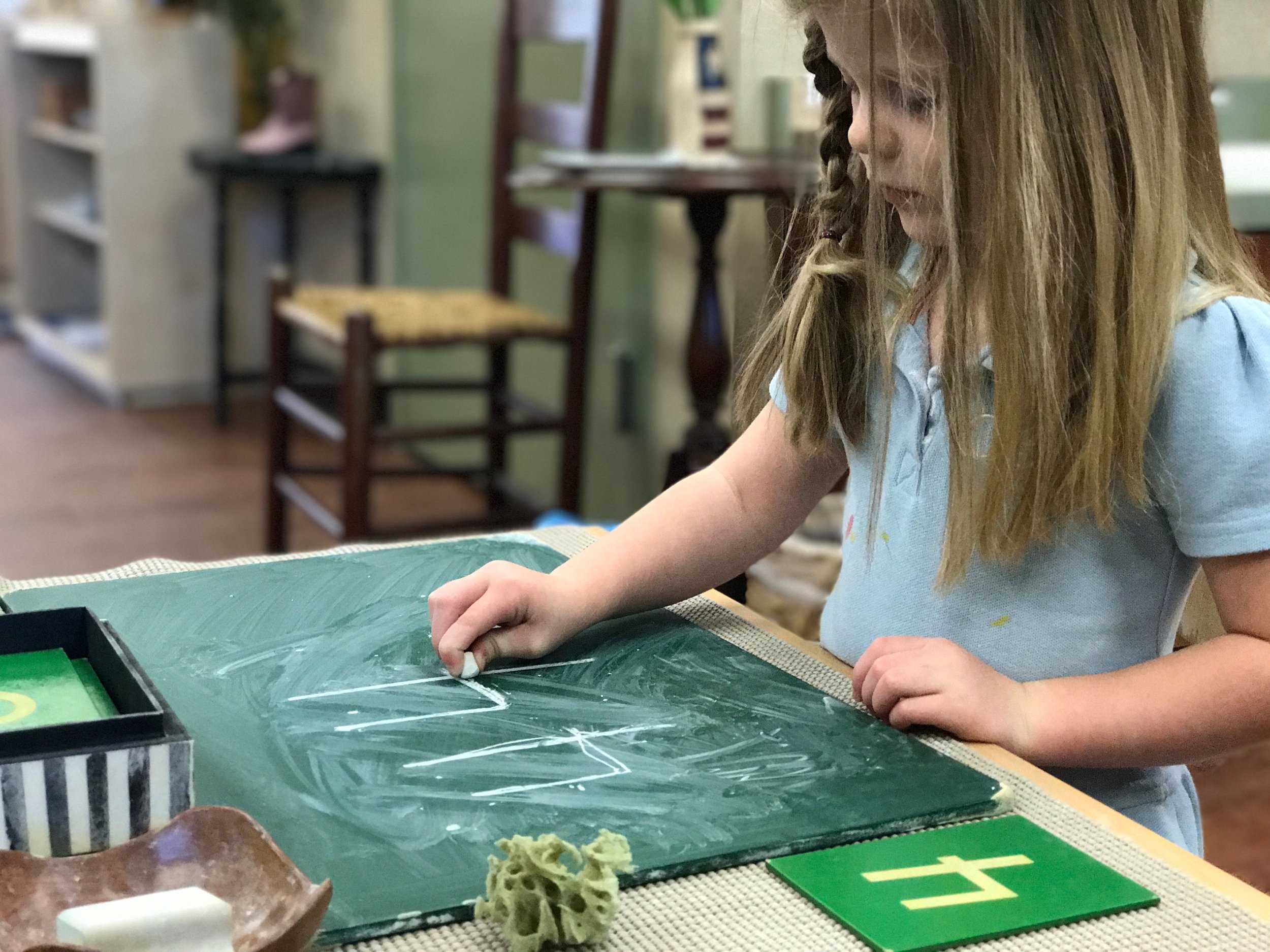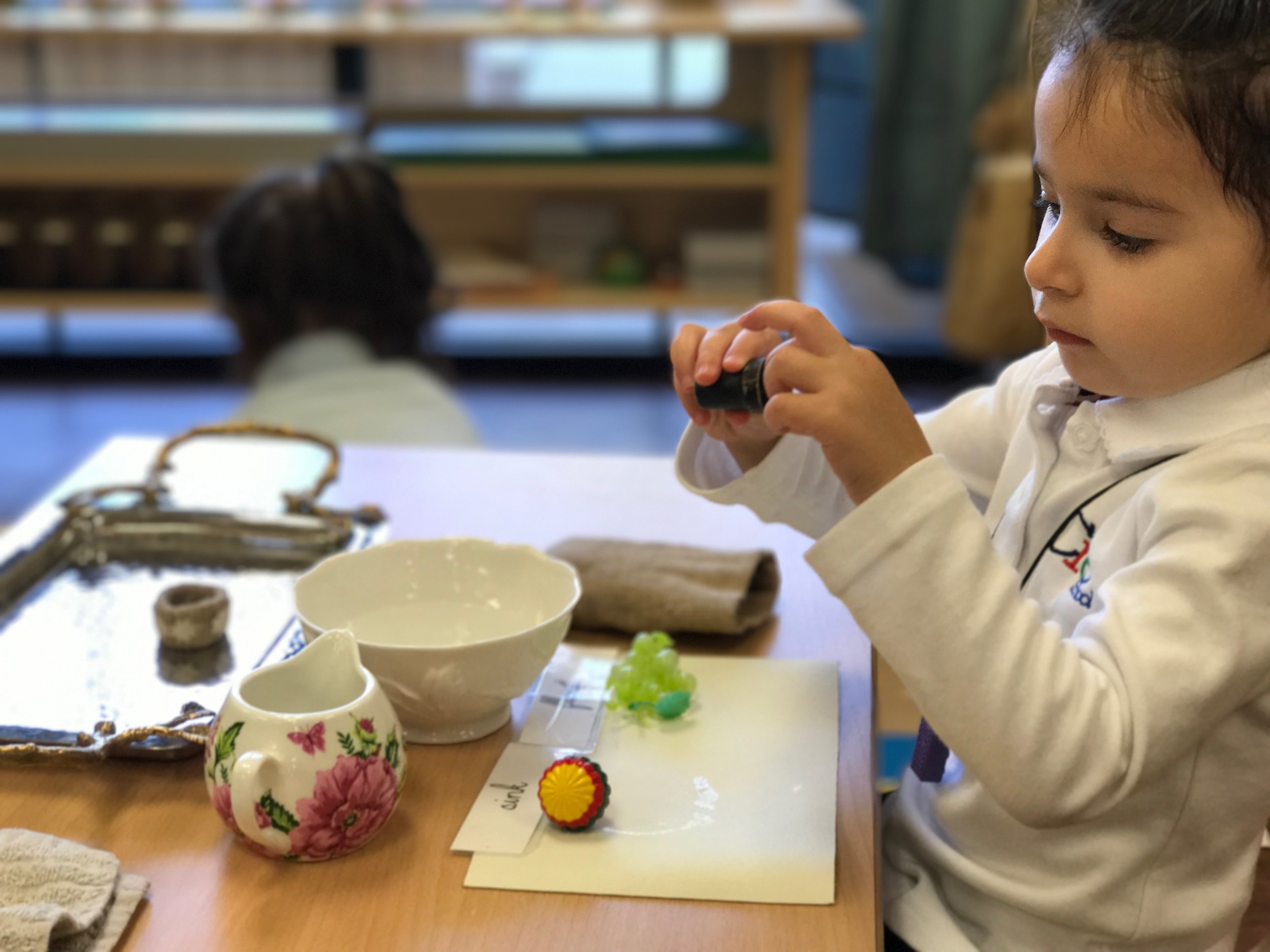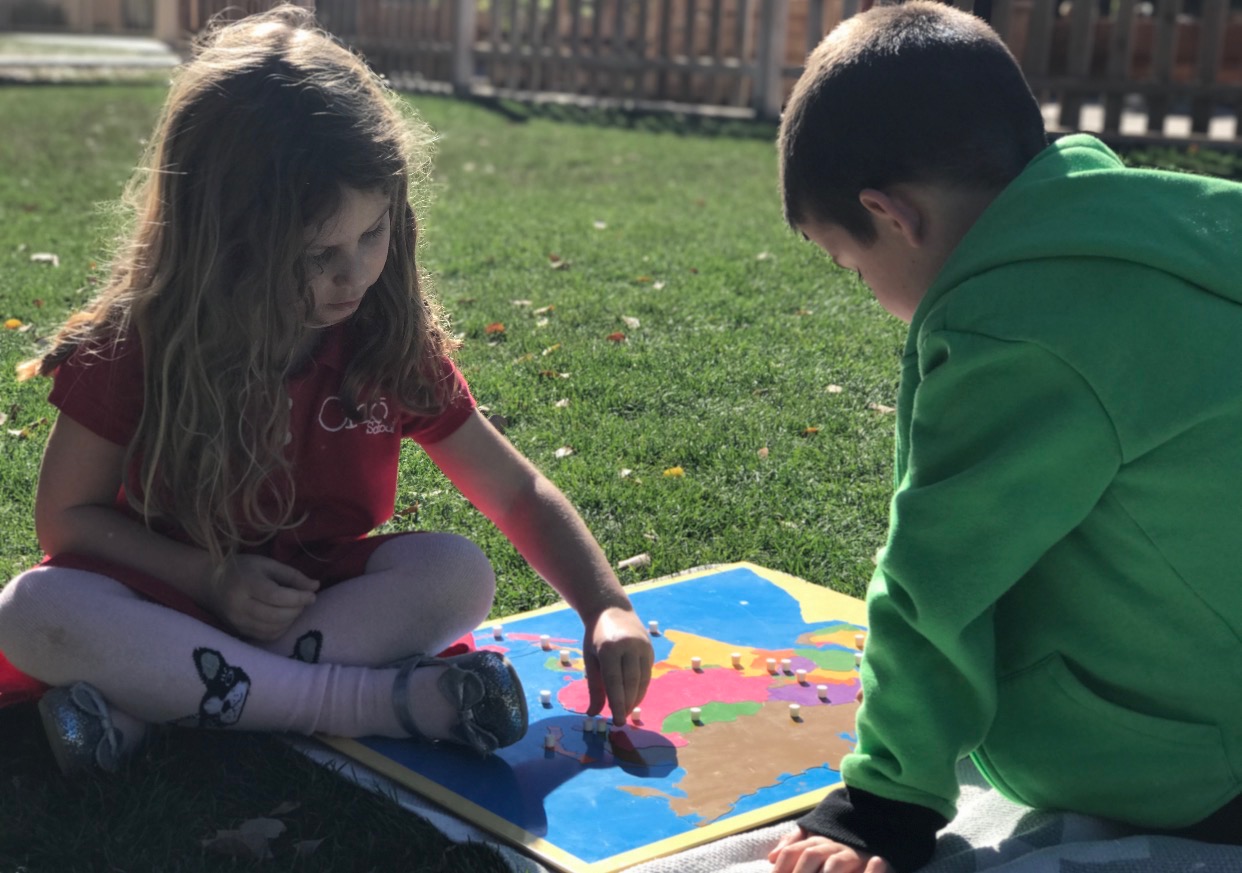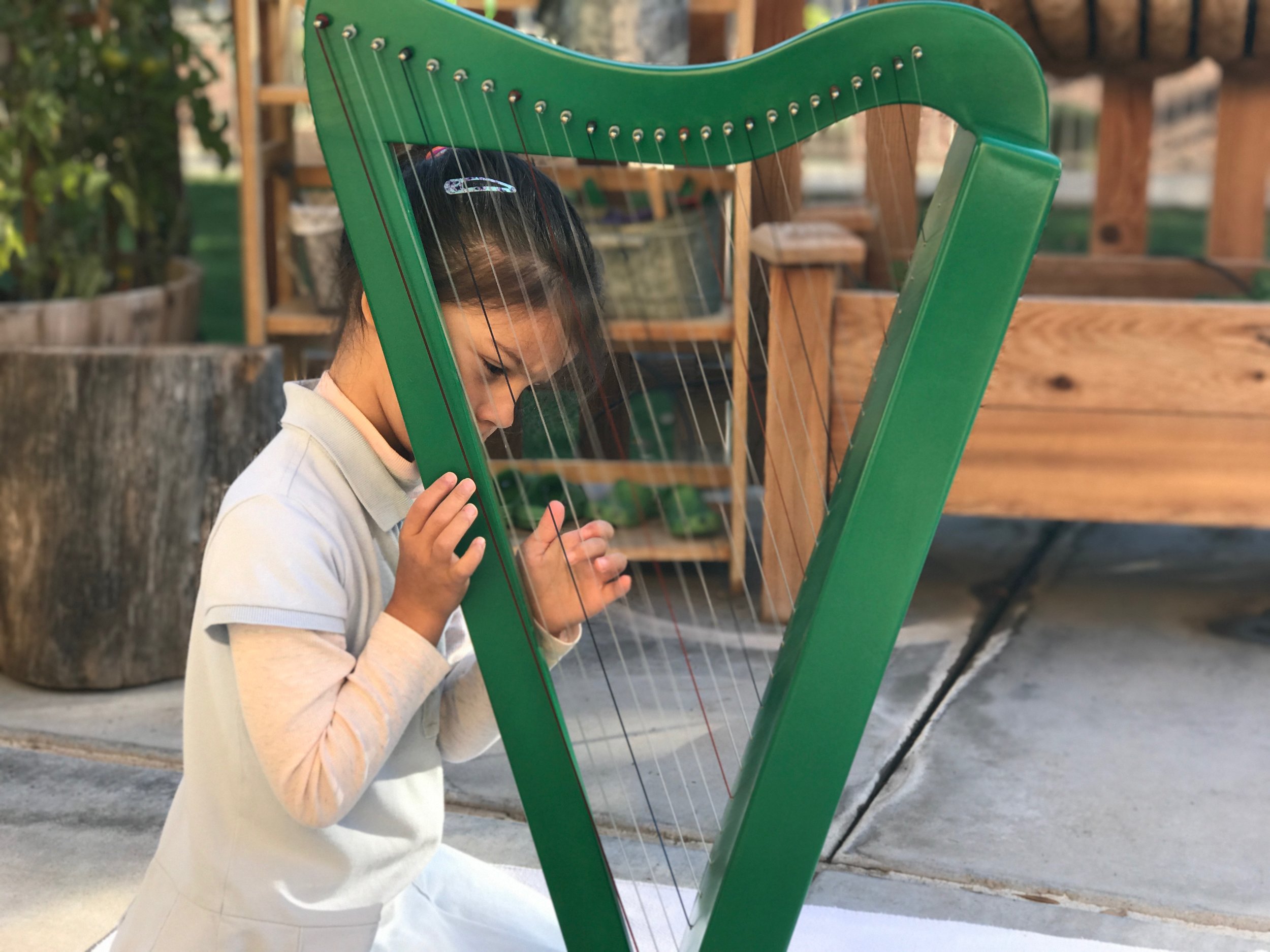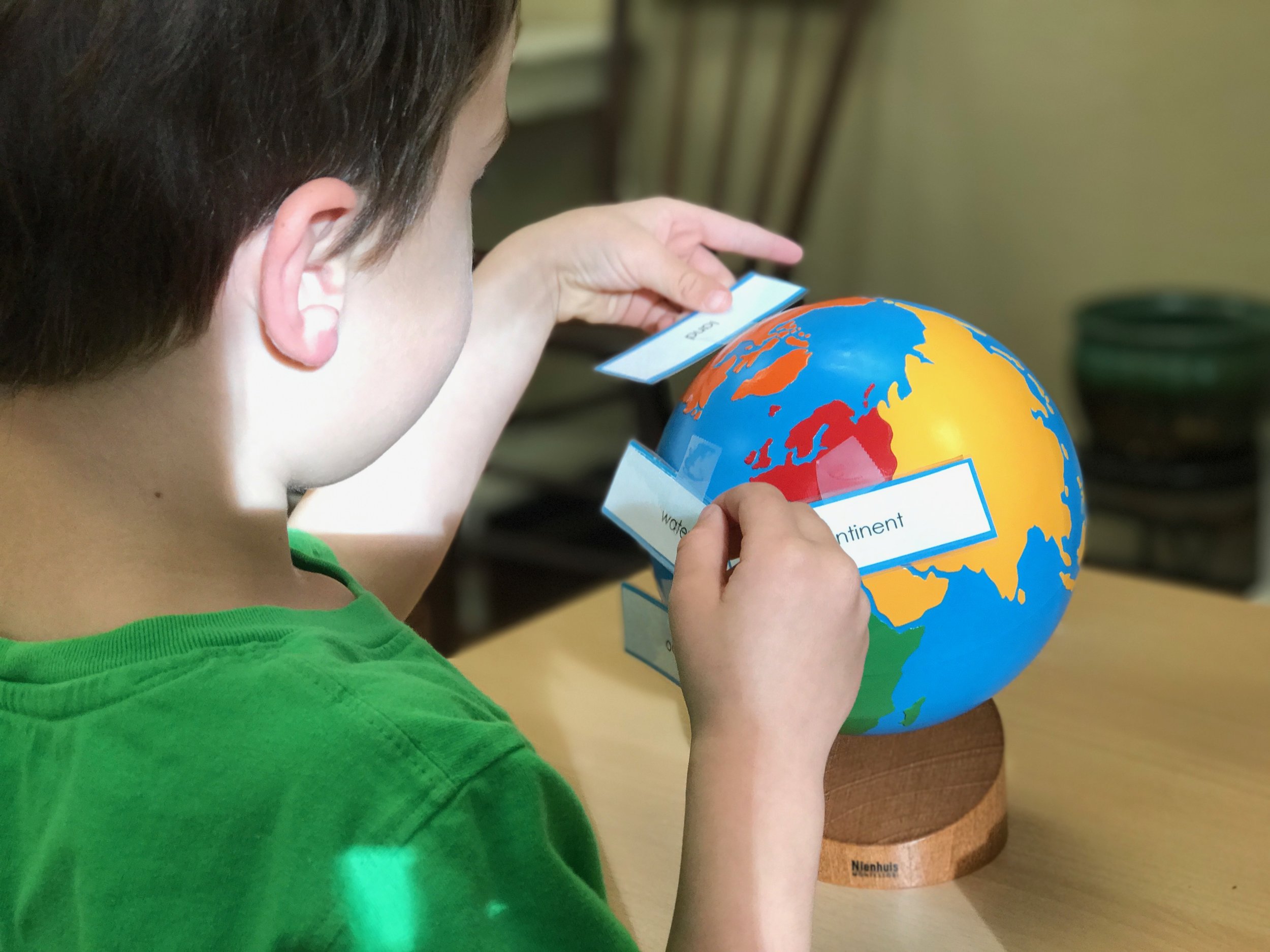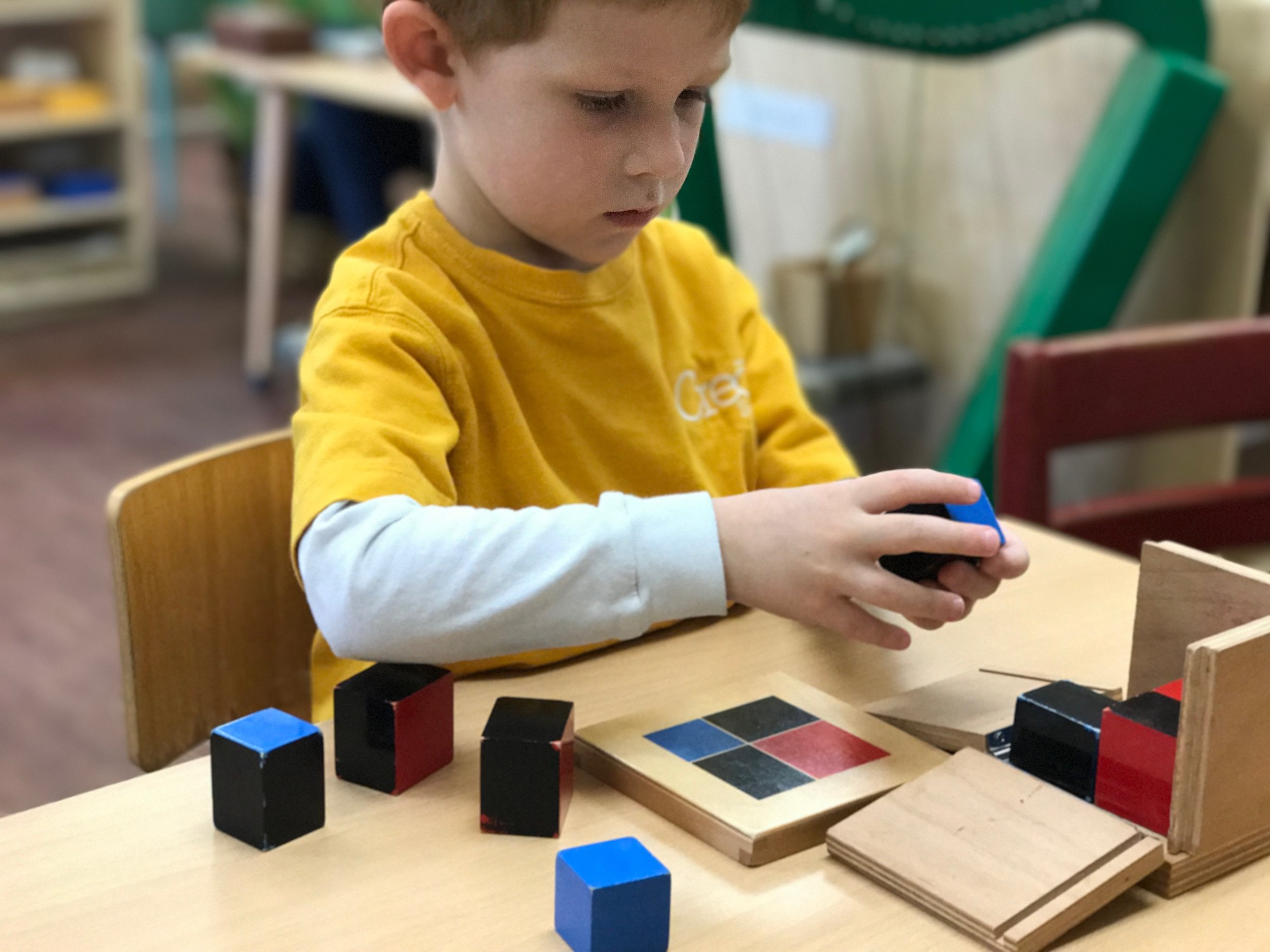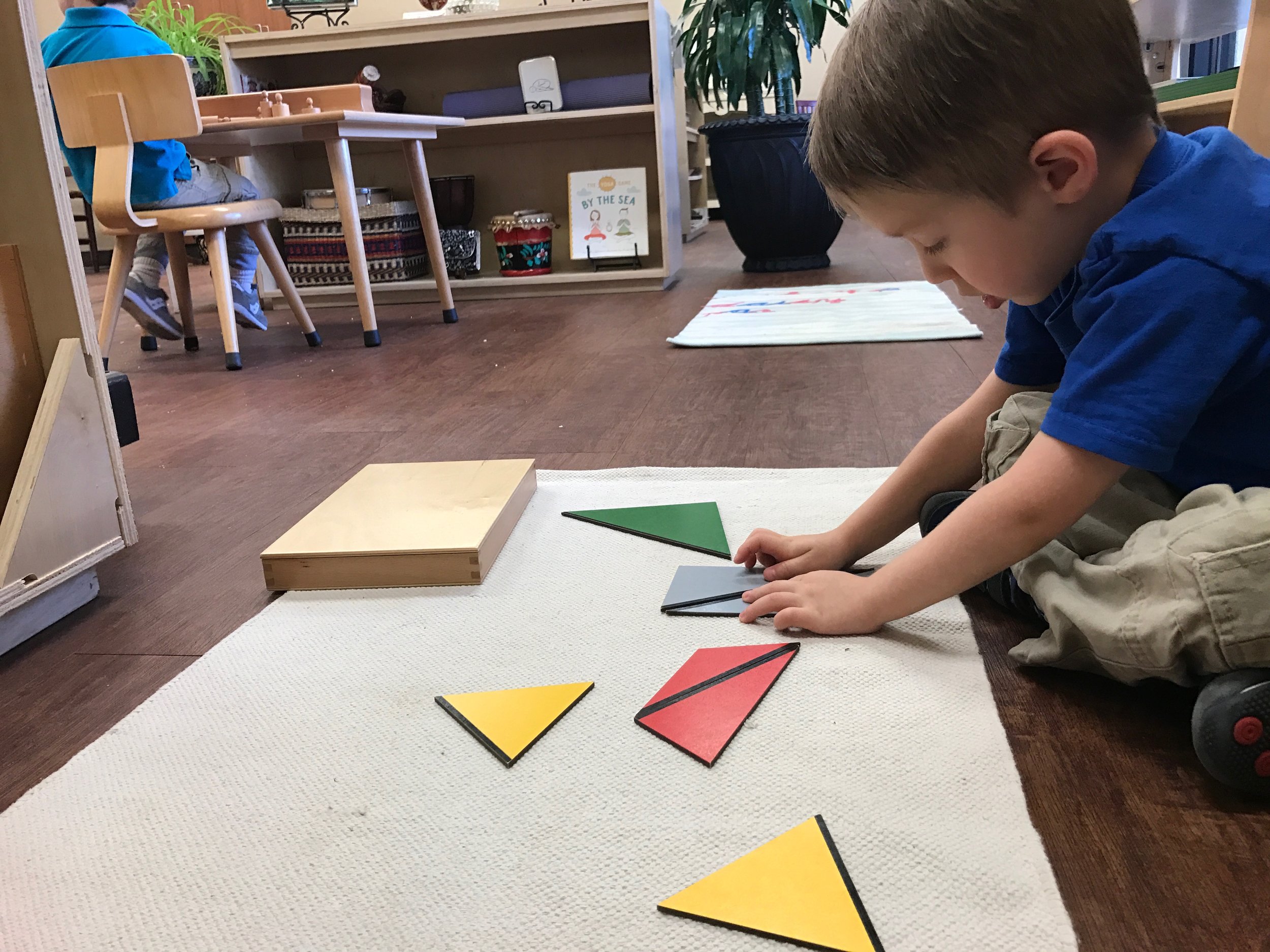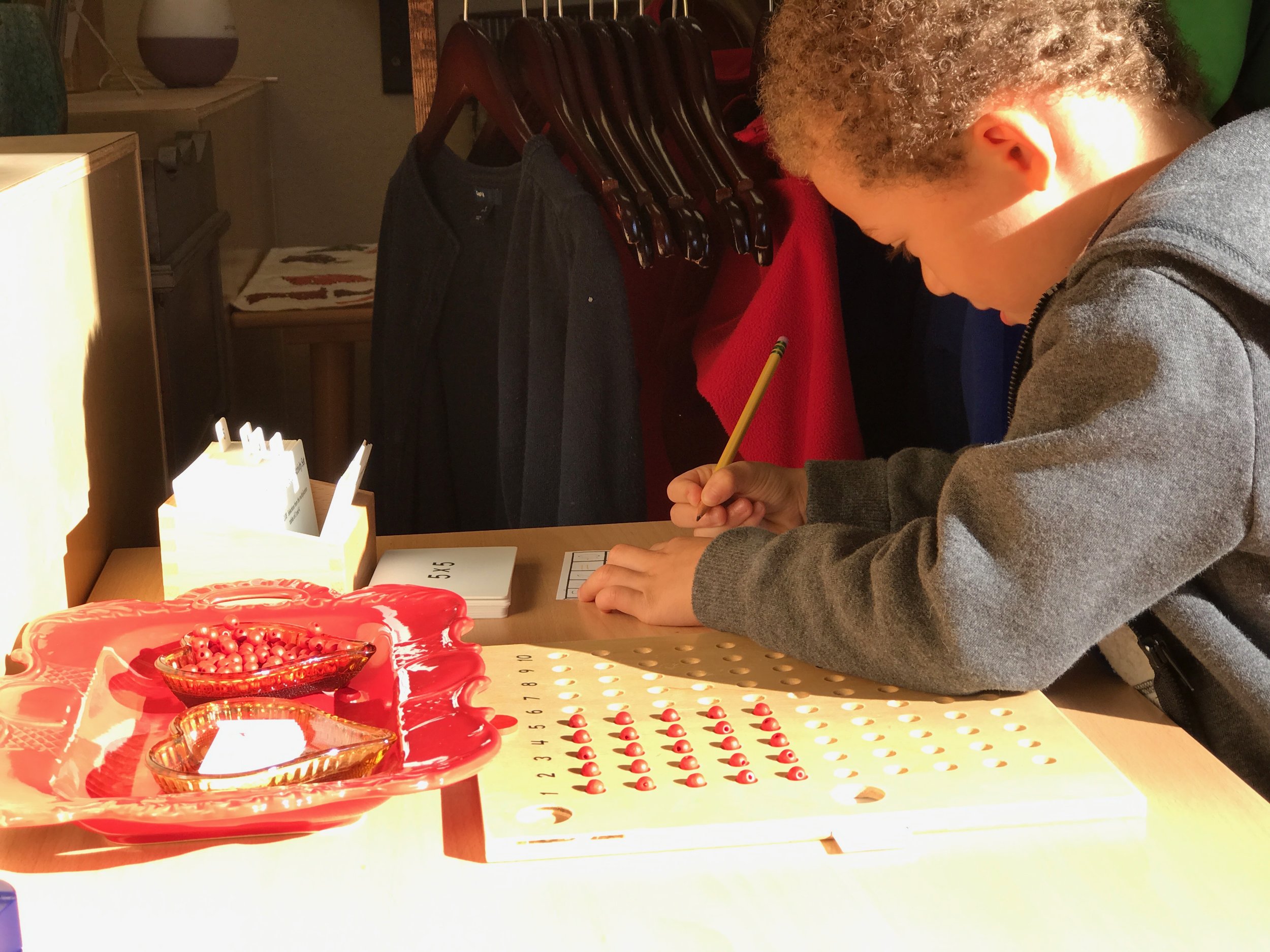The Exercises of Reading
Introduction to the Preparation of Reading
In the Children's House, the preparation for reading is writing. We start by preparing the child's hand through many fine and gross motor skills. Some of these exercises would include, but are not limited, to the knob cylinders, tracing of the geometric shapes, dressing frames, and rough and smooth boards.
As the child is working to develop his/her hand, we introduce the analysis of sounds, such as through sound games like I Spy and the introduction of the sandpaper letters. The sandpaper letters develops an interest in visually connecting the written symbol to the sound representing this symbol.
The synthesis of sounds develops an interest in phonetically building words. The moveable alphabet helps the child strengthen by sounding out all the sounds heard in a particular word the child chooses to build.










Total Reading
There are three areas in the development of total reading in the Montessori environment. This is done through the exercises of mechanical, classified, and interpretive reading.
Mechanical Reading
Mechanical reading starts with the decoding and sounding out words. This is supported with the language exercises of the phonetic object box, phonetic reading cards, rhyming words, phonetic labels of items found in the environment, phonetic commands, and phonetic word charts.
Puzzle words are introduced to the child. These are high frequency words that are meant to be memorized not phonetically sounded out.
The phonogram object box explores a combination of sounds or a singular sound that produces a whole different sound. The children work with phonogram sandpaper letters, phonogram booklets, phonogram cards, and are introduced to the exploration of a consonant phonogram.
Classified Reading
In Classified Reading, labels and definitions of similar objects are brought together. The child starts with the knowledge of words and what they mean from the spoken language exercises in enrichment of vocabulary. Then, the child is guided to read words that she already knows. Later, she will read definitions that she's already familiar with from the spoken language exercises. In this path of classified reading, the child organizes for herself a good deal of precise knowledge about biology, geography, history, music, etc. These readings urge the child on to further studies and research. The lessons include but are not limited to:
- Language related to the names and qualities of sensorial materials
- Objects in the environment
- Classified reading Three Part Cards. For example, parts of the starfish, bird, types of tools, vegetables, landforms, etc.
- Definition Booklets and Definitions in Three Stages.
Interpretive Reading
These are the exercises that have a grammatical base. In Function of Words, the child goes from reading only one word at a time to reading two words together, three words together and finally, longer phrases. These, as in all of the reading exercises, include motor activity on part of the child so that she gets a clear impression of what she reads. She also gains appreciation of syntax and the function of words. Later on, the child will study style with the exercises. An example of a Function of Words work would be the child experiencing verbs by running, hopping, singing and so forth. The child will work with the noun, article, adjective, conjunction, preposition, verb, adverb and pronouns with these exercises. The symbols we use to identify these functions correspond with those used in Montessori Elementary; they offer the child a continuum.
Reading Analysis and Word Study
The child will read in complete sentences. A thought must be read and understood. The child is then shown the various parts of the sentence in a sensorial way to analyze sentence structure. The child is also introduced to punctuation and story webbing through these exercises. In Word Study, the children have opportunities to explore reading parts of speech and the technicalities of the English Language including spelling with homophones, rhyming words, singular and plural, suffixes, etc.
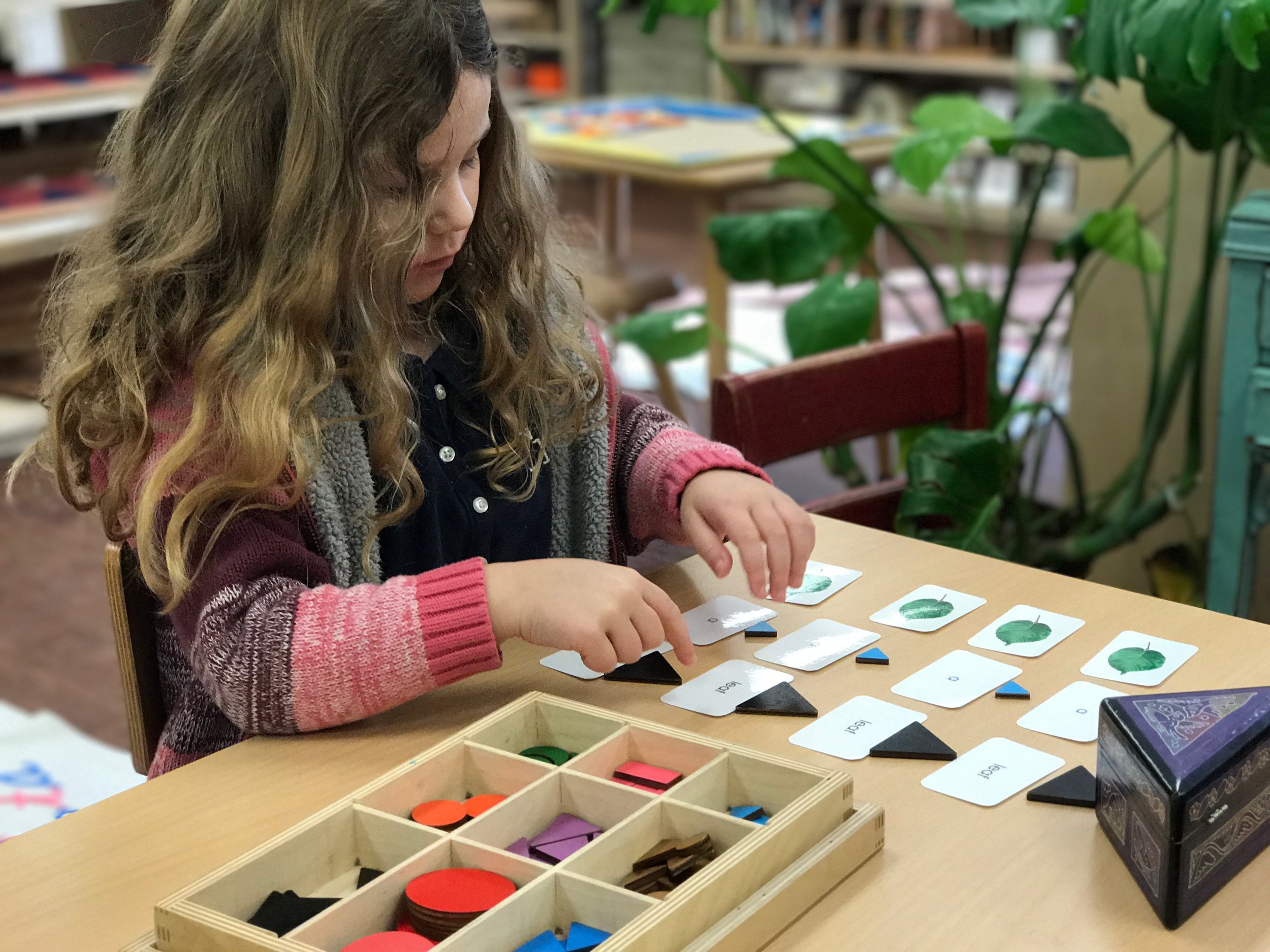
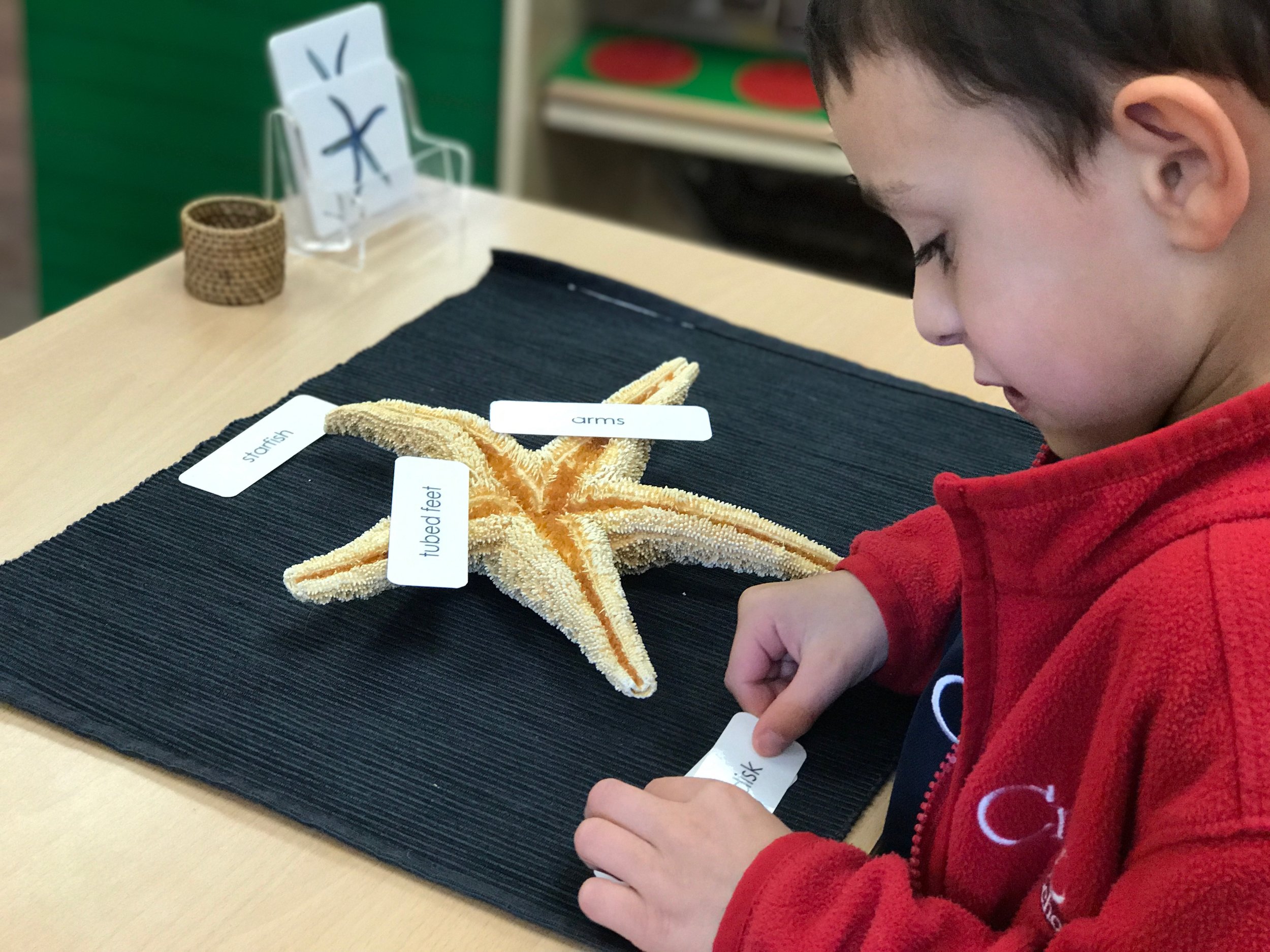


Extensions into Culture and Science
Geography is a study of how humans live, it is a study of the places, societies and cultures. In the Children’s House, once a child is a reader, she is extremely enthusiastic to use this new tool to connect to the world outside of his daily environment. She likes to read about the countries which she previously has been working on through Puzzle Maps, and to read about celebrations and culture facts of these countries. Learning about the food, clothes, festivities, etc. is quite an amazing experience for the child. The Geography Folders contain classified pictures for each of the continents and a detailed explanation at the back. The child whom has been working with Land and Water forms can now read and label the Land and Water Form’s Classified Cards.
The interest in nature is a natural thing in every human specially in children. We can divide it into two major fields, Botany and Zoology. Botany is the analysis of the classification of plants and their structure while Zoology is study of animals and their classifications. In the Children’s House, both fields are covered as extensions to reading. For instance, the study of “Part of a Butterfly” focuses on the external body parts of a butterfly. When the child learns the parts and how to label the parts, later the child will earn to read a few sentences regarding each part and learn to match the paragraph with a proper label. At last, the child is comfortable enough to read the sentences of the paragraph in separate labels and make the proper paragraph according to its label. These definition sets come as “Part of …” external body parts of animals or parts of a tree or leaf etc. Labeling the leaves at the Botany Cabinet is another activity as the extension of botany to reading.
Reading plays a big role in Music in the Children’s House. As we spoke about written language in our last blog, we mentioned how the child learns to compose or write music using the Montessori Bells. The child learns to label each tune and read a series of labels (melody) from the Music Staff board. This is quiet an astonishing experience to be able to read a musical note made from someone else’s thought or his own. Music, as an extension of language, additionally contains the name of composers and their work, as well as the classified cards about Musical Instruments.






A Peek Inside Our Children's House Classrooms
Bobcats
It has been blissful to observe the children enjoy the materials. We are establishing relationships with new children who recently joined our classroom since returning from Winter Break. We take this as a golden opportunity to represent Grace and Courtesy lessons to the whole class. We are reaching our full capacity and it is amazing to see how the children’s characteristics blend in with one another and form a calm yet busy environment.
As the weather is getting warmer we are preparing our garden to start planting new plants. The children are greatly excited to take a role in picking up dead leaves and preparing the soil for our new vegetable plants and flowers.
I would like to thank all the parents who attended our last community meeting. Your positive comments and continued support is always appreciated.
Sincerely,
Ms. Mahsa and Ms. Dinora













Cactus Wren
The weather has been amazing. The children are enjoying the Outdoor Environment. Recently, they discovered a pair of morning doves that were building a nest above an outdoor light fixture. This has caused an interest in where animals and people live. We have read books about the different areas animals call home. We even explored different homes from around the world. The children were surprised to learn that there are homes around the world where the bathroom is outside of the home!
Thank you again for all your support and your commitment to your child's education.
Ms. Johna and Ms. Eugenia










Gray Fox
Happy almost Spring, dear families! This time of year is always so magical as the sun beats upon our souls, creating new life and love as the vegetation springs back and new creatures appear in our gardens. We can say with confidence that through our observations we constantly note the happiness of the children. We are always giggling with them in our Gray Fox class. They are beaming with joy as friendships flourish, independent confidence continues to strengthen, and the unique personalities display themselves in new ways.
“And whoever is happy will make others happy too.”
We have been focussing on kindness over the past several weeks, how to demonstrate care for one another as well as the Earth, our home. We have started the process of getting our compost up and running again by discussing which types of things can be composted. Our goal is to bring awareness of (recycling and reducing) the waste we produce and to reinforce the importance of eating nutritionally. The children have been excited for the opportunity to dissect and press their beautiful plants and flowers, thank you for your support and contribution. We are looking forward to our Charity Event, it will be nothing short of wonderful.
Warmly,
Ms. Lauren and Ms. Yadira


